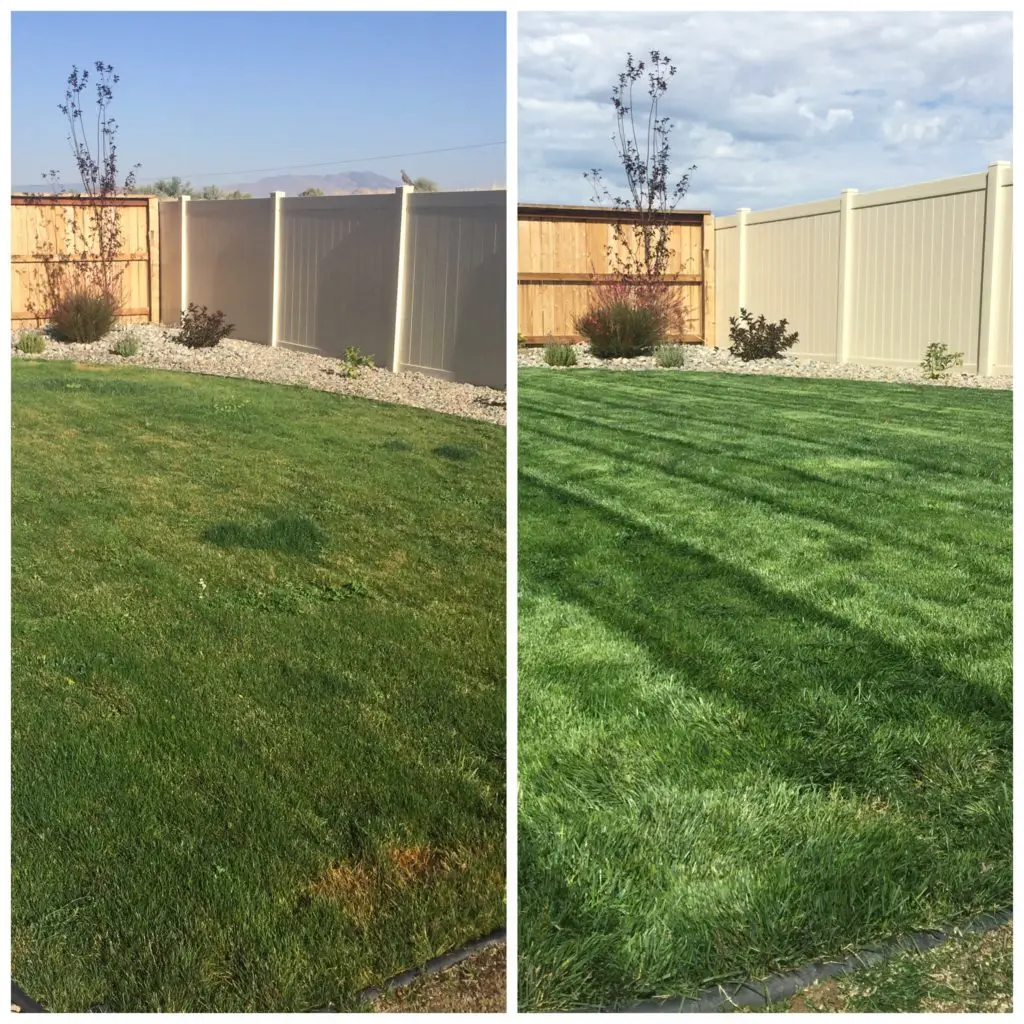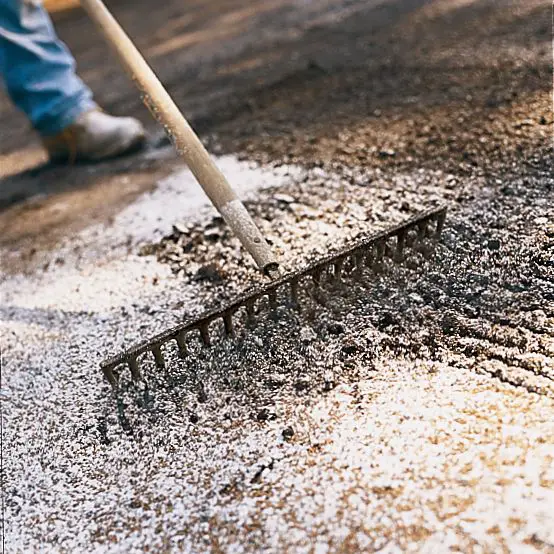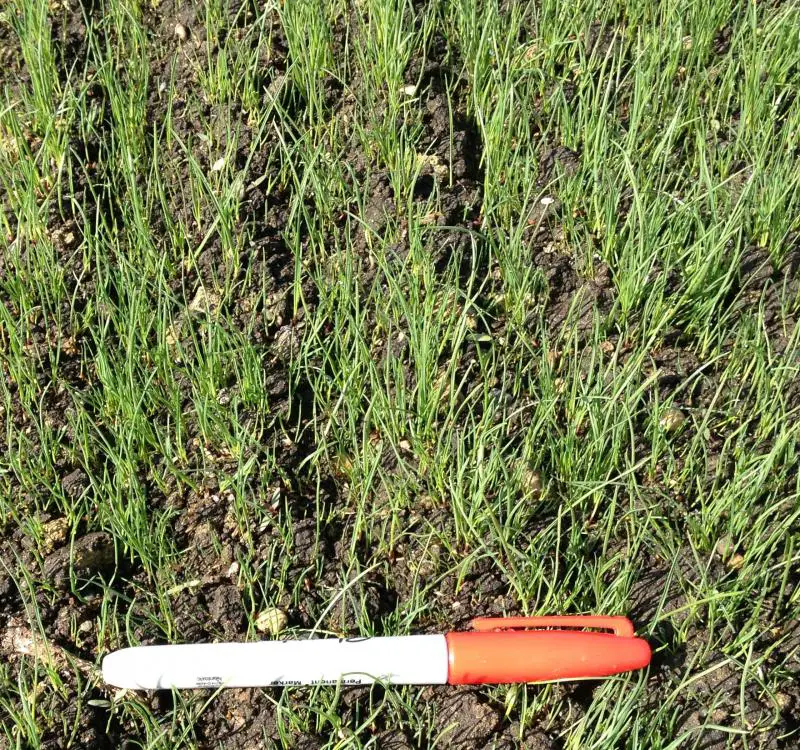Does Grass Seed Need To Be Covered With Soil
Grass seed can grow if not covered, but it is usually beneficial to add a layer of compost, topsoil or straw mulch over the top of your seed to keep it from drying out. Seedlings can be transplanted directly into a potting mix, or you can plant them in a container with a drainage hole in the bottom to allow water to drain away from the roots.
You can also plant seedlings in containers that have drainage holes in them, such as a large pot with holes cut in it. The holes should be at least 1/2 inch in diameter and 3/4 inch deep, so that water can drain out of the container. If the holes are too small, the seedling will not be able to root properly, and you will have to transplant it to a larger pot.
Return To Regular Maintenance
Keep your newly revived lawn looking its best with a regular, comprehensive maintenance plan that includes diligent watering, best mowing practices and proactive overseeding. A simple weekday lawn maintenance schedule can keep your lawn lush and your weekends free.
For a simple, all-in-one approach to a thicker lawn, you can put your lawn on the fast track with Pennington Lawn Booster. This easy-to-use product simplifies overseeding to give your lawn the boost it needs. In just one application, your lawn will grow quicker, thicker and greener than ordinary grassguaranteed.
Available in formulas for sun & shade or tall fescue lawns, Lawn Booster combines three essentials: seed, fertilizer and soil enhancer. Lime-enhanced, pure-bred Pennington Smart Seed, backed by years of breeding and research, adds beauty and sustainability. Once established, these water-conserving grasses require up to 30 percent less water than ordinary grasses. That’s year after year, for the life of your lawn. Plus, they stay green up to three weeks without watering. That means less work and more leisure time for you.
For the lawn of your dreams, don’t wait to overseed until your lawn looks less than its best. Give your lawn the boost it needs, step-by-step or all-in-one. Pennington’s here with premium grass seed and lawn care products to help you keep your lawn at its peak.
Pennington, One Step Complete, Smart Seed, and Ultragreen are trademarks of Pennington Seed, Inc.
Sowing Of New Grass Seeds
Seeds Spreading: Finally, its time to spread the seeds. You can spread seeds by hand if there are only one or two bare spots. For the whole lawn, its better to use a rotary spreader. Typically, the spreading of 2 to 4 pounds of seeds per1000 square feet is enough.
Watering: After the seeds are sown, you have to keep the ground moist. Watering for at least two to three times is necessary for the next 10 to 14 days. When you see the sprouts emerging, water for at least once a day. The watering schedule should be early in the morning, during windy days avoid using sprinklers as the wind can dry the moisture.
Don’t Miss: How To Rejuvenate Your Lawn
Can You Overseed Over Dead Grass
A direct answer to this is simply yes, you Can seed over dead grass. However, I dont recommend this at all as it will simply make your lawn look like a mess and even abandoned.
If your lawn is only composed of dead grass, then its best that you remove the dead grass completely.
If your lawn only has a few spots with dead grass, just remove those spots and make sure that you put enough seed on those areas.
Generally, total lawn renovation is best if your lawn only has dead grass. This is to make sure that your lawn ends up looking good once the seeds have already grown.
Related post:Will Watering Dead Grass Bring My Lawn Back Life?
Should You Till Your Lawn Before Seeding

Before seeding your lawn, till the soil to relieve compaction. After a new construction, heavy equipment and traffic can often pack down the soil. When the soil is moist but not so wet, it sticks to the tines. Its best to only go over the yard once or twice a year.
Mow the lawn at least once a week. Mowing is the best way to keep the grass healthy and healthy-looking. If you mow too often, you may damage the roots of the plants and cause them to wilt and die.
Recommended Reading: What Kills Moss In Your Lawn
How To Plant Grass Seed On Hard Dirt
It is common to have one part of your lawn having hard dirt that tends to choke the life out of any grass that tries to grow therein, but this can be reversed. It just requires more care to achieve the ideal state for grass growing and give your dry lawn a whole new look. With the following steps, coupled with lengthy preparations, you will be able to reverse the hard dirt into a more welcoming loamy soil for a beautiful lawn.
Wise Procedure Of Overseeding
Hopefully, now you better understand which grass will grow well on your own depending on the climate of the region.
You might be wondering about the procedure of overseeding. Dont be concerned, it is quite easy. You just need to follow the steps mentioned below. So, have a look to know what are these:
Read Also: How To Repair Dead Spots In Lawn
How To Plant Grass Seeds On The Existing Lawn In The Fall
Are you concerned about planting grass seeds on the existing lawn in the fall? If yes, you should not worry. Its procedure is similar to that of overseeding in spring with the only difference of sowing seeds in the aeration holes. You should select the climate favorable grass just like cool-season grasses are bluegrasses, fine and tall fescues, and ryegrasses.
Shortly, overseeding of the cool-season grass needs aeration of the whole lawn. After this, fall the seeds in the aeration holes. You can also use the back of a rack to put more seeds in the holes. It is a pro tip to prevent the seed from drying out in the cool weather. As a result, the seeds will germinate quickly.
Apply the fall fertilizer and water the seeds one to two times a day. Normally, the seeds require 2 weeks to germinate. Once the new grass reaches the height of the existing grass, you can use a mower to manicure the lawn.
Is April Too Early To Plant Grass Seed
You can plant grass seed too early in the spring. Poor germination can be caused by planting too early in the spring. Wait for the air and soil temperature to warm up so that you can plant your seed. The best way to tell if your seeds are ready for planting is to look at them.
If they are green, then you have a good chance of planting them successfully. The reason for this is that the seed coat is not fully formed. This means that it will take a long time for it to grow into a healthy plant.
Recommended Reading: What Is The Best All Wheel Drive Lawn Mower
Advantages Of The Overseeding
Overseeding can do wonders for your garden. It only requires your attention and your garden will surprise everyone. So, lets figure out the advantages of the overseeding.
- Overseeding gives robustness to your yard.
- As a result of dethatching, the soil gets proper sunlight and air.
- It helps in controlling pests and fungus.
- It improves the drought tolerance of grass.
- A healthy lawn gives you freshness.
For your convenience, we have explained cool and warm-season grasses in detail. So, you can select the best one.
Can You Just Throw Grass Seed Down And It Will Grow
Grass seeds are not strong enough to grow through soil. They are supposed to be placed on top of the prepared soil. Germination can be affected by too much soil on top of the seeds. The best way to plant grass seeds is to place them directly on the soil surface.
If youre planting them in a container, youll want to cover the container with a layer of peat moss. This will help prevent the grass seed from drying out. You can also place the seed directly in the potting soil, but be careful not to overdo it. Too much moisture can cause the plant to wilt and die.
Read Also: How Much For Lawn Irrigation System
Is It Ok To Lay New Turf Over An Existing Lawn
The general agreement amongst gardeners seems to be that laying new turf over an existing lawn would be likely to cause problems with the new grass forming its proper root structure, but having said that, there are some remarkable success stories admittedly mostly from the US which suggest this method can work really rather well.
Is Bagged Topsoil Any Good

A. Bagged soil can vary enormously in quality, but the fine print on the bag can provide clues. Some products labeled “top soil” are, contrary to the name, not good for planting. … Bagged compost and manure products typically cost about the same as top soil at big discount lawn and garden centers.
You May Like: How To Get Rid Of Unwanted Grass In Lawn
Choosing A Professional Lawn Aeration And Overseeding Service
Now that you have an idea how to get better results when overseeding a lawn, you might be looking for a professional lawn aeration service. Weve written a blog article on DIY aeration and why its not the best idea. Most homeowners are disappointed with the subpar results they receive when attempting to aerate on their own.Thats why choosing a pro is the best choice.At Master Lawn, we believe that aeration is one of the most important things that you can be doing for your lawn for the reasons that weve explained. Its included in our Platinum program and can be added to our Gold or Silver lawn care programs as an add-on service.When you choose professional aeration followed by overseeding with high-quality seed, you can get on your way to the amazing results youve been wishing for.Ready to have a lawn that you love at your Memphis area home? Talk to a lawn care expert, choose from 3 program options, and become the master of your lawn.
How Much Seed To Use
Too much or too little seed produces inferior results. Grass species should be seeded at the following rates.
- Kentucky bluegrass: 3 to 4 pounds/1,000 square feet
- Perennial ryegrass: 7 pounds/1,000 square feet
- Turf-type tall fescue: 7 pounds/1,000 square feet
- Fine fescues: 5 pounds/1,000 square feet
- Buffalograss: 3 to 5 pounds/1,000 square feet
Recommended Reading: How Much Should I Water Lawn
Do A Soil Test Then Add Amendments
Once you have renovated your lawn exposed and leveled the planting surface youll need to test your soil for the best grass germination and growth. Test the soil as soon as you can. There can be a wait of up to two weeks for results and you could miss your ideal planting window.
At a minimum, you should test for pH. This is a measurement of the acidity or alkalinity of your soil. Most grasses like slightly acidic soil, with a pH of 6.2 to 7.
A simple moisture and pH tester can be found for $10. For about $20, you could test for the major nutrients in your soil. Your results will show the N, P, and K: nitrogen, phosphorus, and potash.
The best soil tests include major and minor nutrients. Your state Extension service and private labs offer these services. Keep in mind your local Extension office can also provide great information and insight that private labs cant, and usually at a lower cost.
Here are four very good soil tests you can buy on Amazon.
The test results should give you a plan and shopping list for your local garden shop. Follow application instructions carefully and add soil amendments to restore what it lacks. Again, use a tiller or hand tools to work the amendments in to a depth of 1-4 inches.
How To Plant Grass Seed In Texas The Best Explanation
The best time to seed your lawn is during the winter or fall season. The reason for this is that both seasons have periods when the grass will be going into dormancy in preparation for the coming cold of winter. The heat from summer would have left your lawn in a bad condition.
If you want to get the most out of your grass seed, you need to make sure that you are using the right type of seed for your particular lawn. For example, some grasses are better suited for certain areas of the lawn, while others are more suited to other areas. This is why it is so important to choose the best seed that is right for you and your yard.
You May Like: How To Fix Brown Spots In Lawn
Should I Soak Grass Seed Before Planting
It is recommended that you only soak most seeds for 12 to 24 hours and no more than 48 hours. … After soaking your seeds, they can be planted as directed. The benefit of soaking seeds before planting is that your germination time will be reduced, which means you can have happy, growing plants faster.
Choose The Right Seed
This is the most important step, get this wrong and you may end up making your lawn look worse rather than better. Different species of grass can look very different so you want to avoid mixing types if at all possible. If you are unsure a mixed seed containing a few different kinds of grass could work well as it will help blend the different grasses together. Look for a mixed seed with ryegrass and fescue.
Read Also: Is Sunday Lawn Care Worth It
Single Variety Blend Or Grass Seed Mix
In addition to high-quality grass seed to match your climate, you also need to consider your lawns unique properties.
- Is it in full sun, shade, or a mix? A shade mix is great for dense shade.
- How much moisture will it get?
- Is the area heavily trafficked?
- How much time and effort do you want to spend maintaining the lawn?
Knowing your terrain will help you home in on the formulation of seed you want. Seeds are sold as pure seeds of one variety, blends , and mixtures .
Pure seed will give you a unified look. Blends will be less uniform, but one variety may cover up for the weaknesses of another. Grass seed mixtures provide the most biologically diverse lawn: the grass plants wont look identical, but your lawn has a better chance of surviving diseases and droughts.
Come Up With A Maintenance Routine For Your Lawn

Your lawn maintenance includes watering, mowing, and fertilizing only when its needed. When the grass is fully grown, watering should only be done once a day.
Mowing and weed control is also important. As soon as you see weeds growing out, make sure you have them removed immediately.
When it comes to fertilizing, the best time to do overseed your lawn is every spring or when the temperature is around 55 degrees Fahrenheit.
Six weeks after the germination process, you can use quick-release nitrogen fertilizer again.
Just make sure that you avoid overfertilizing as this could also kill your grass. Nitrogen fertilizer, in particular, can burn the grass and dry them out quickly.
Also Check: How To Kill Foxtail In Lawns
Establish A Good Care Routine
As your new grass areas reach the height of your existing grass areas, you can begin to mow on a regular basis. Itâs also important to establish a good care routine for your newly sprouted grasses. Regular fertilization and weed control is a fundamental action that can make a big difference in the life and health of your yard. Year-round lawn care addresses the unique needs of Colorado lawns through routine applications of fertilizers and weed/pest control agents. Contact us today to learn more about our affordable options and make the most of your lawn.
Planting grass seed on existing lawns is an easy pick-me-up to embattled lawns that need a little extra filling out. Follow our four easy steps and your lawn will be lush and full in no time at all.
The Best Grass Seed To Use
Choosing the best grass seed will depend on your location, how much sunlight the lawn receives, and whether it needs to be durable enough to withstand backyard soccer games.
Identifying what grass currently grows in your lawn will give you a great indicator of what likes to grow there, says Hedges Gower. Choosing the same variety makes success far easier in the long run.
Grasses are broadly made up of cool-season and warm-season varieties which type you choose will depend on your local climate.
Cool-season grasses include fescue, ryegrass, Kentucky bluegrass and bentgrass, which grow better in cooler climates. Bentgrass and fescue are widely used in seed mixes, while ryegrass is particularly tough so a good choice for families.
Also known as Southern grasses, warm-season grasses include Bermuda grass, zoysia grass, St. Augustine grass and centipede grass. They thrive in areas with hotter summers and milder winters.
Bermuda and zoysia grasses are widely used throughout the south, while centipede grass is a good low-maintenance choice. St. Augustine is more shade tolerant than other warm-season grasses.
Many lawns are made up of a seed mix, rather than a single variety. Seed mixtures are generally a blend of species to suit most lawns and guarantee a better strike rate, says Hedges Gower.
However, be aware that seeding ryegrass, for example, into a traditional lawn mixture will stand out like a sore thumb, and vice-versa.
You May Like: How To Replace Lawn Chair Fabric